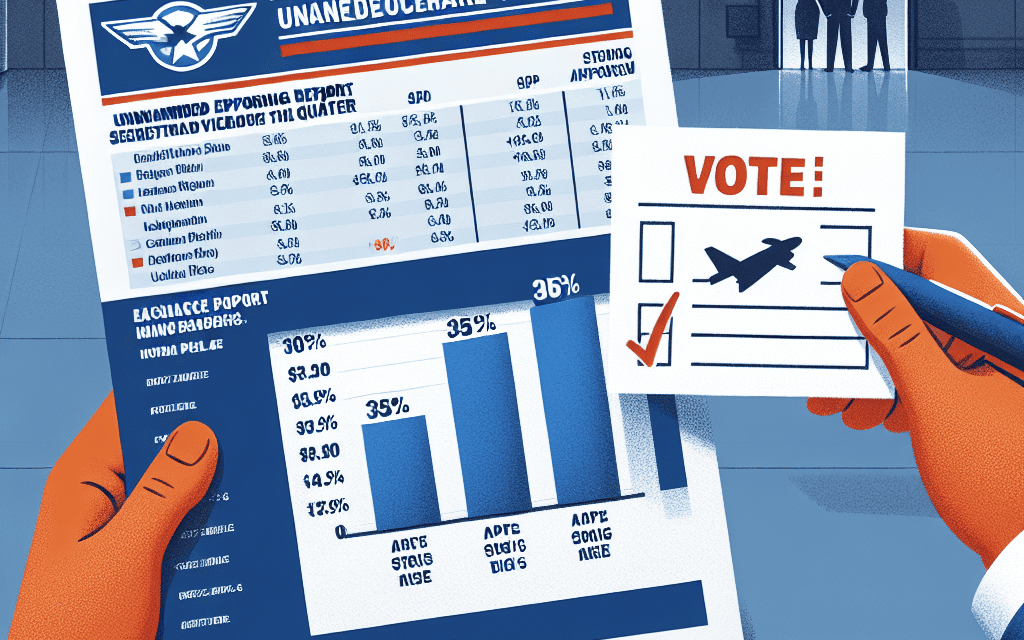“Boeing Faces Turbulence: Q3 Losses Soar as Union Workers Eye 35% Pay Raise”
Introduction
Boeing, the aerospace giant, has reported a significant financial setback in its third-quarter earnings, coinciding with a pivotal moment for its workforce. The company disclosed substantial losses, underscoring ongoing challenges in its operations and market conditions. This financial turbulence comes as Boeing’s unionized workers are poised to vote on a proposed 35% pay raise, a decision that could have far-reaching implications for the company’s cost structure and labor relations. The juxtaposition of financial strain and potential wage increases highlights the complex dynamics Boeing faces as it navigates economic pressures and seeks to maintain its competitive edge in the global aerospace industry.
Impact Of Union Workers’ Pay Raise On Boeing’s Financial Health
Boeing, a titan in the aerospace industry, recently reported a significant financial setback in its third-quarter earnings, a development that has sent ripples through the business community and raised questions about the company’s financial health. This downturn coincides with a pivotal moment for Boeing’s workforce, as union workers have voted in favor of a substantial 35% pay raise. The juxtaposition of these events has sparked a debate about the impact of labor costs on the company’s financial stability and future prospects.
To understand the implications of the union workers’ pay raise on Boeing’s financial health, it is essential to consider the broader context of the aerospace industry. Boeing, like many of its peers, has been navigating a complex landscape marked by supply chain disruptions, fluctuating demand, and increased competition. These challenges have already placed considerable pressure on the company’s margins. The decision by union workers to secure a 35% pay increase adds another layer of complexity to Boeing’s financial equation.
The approval of the pay raise reflects the growing influence of labor unions in advocating for better compensation and working conditions. For Boeing’s workforce, this increase is a significant victory, promising improved living standards and job satisfaction. However, for Boeing’s management, it presents a formidable challenge. The company must now balance the need to reward its employees fairly with the imperative to maintain financial viability in a highly competitive market.
The immediate impact of the pay raise is evident in Boeing’s third-quarter financial results. The company reported a substantial loss, which can be partly attributed to the increased labor costs. While Boeing has not explicitly linked the pay raise to its financial performance, the timing of these developments suggests a correlation. The increased labor expenses are likely to strain the company’s resources, potentially affecting its ability to invest in research and development, expand its product offerings, and compete effectively on a global scale.
Moreover, the pay raise could have long-term implications for Boeing’s cost structure. As labor costs rise, the company may face pressure to increase the prices of its products and services, which could impact its competitiveness. Alternatively, Boeing may need to identify cost-saving measures in other areas of its operations to offset the increased labor expenses. This could involve streamlining processes, enhancing operational efficiency, or even considering workforce reductions in non-unionized segments.
Despite these challenges, it is important to recognize that the pay raise also presents opportunities for Boeing. By investing in its workforce, the company may benefit from increased employee morale, productivity, and loyalty. A satisfied and motivated workforce can contribute to improved operational performance and innovation, which are critical for Boeing’s long-term success. Furthermore, by demonstrating a commitment to fair compensation, Boeing may enhance its reputation as an employer of choice, attracting top talent in a competitive labor market.
In conclusion, the union workers’ 35% pay raise represents a significant development for Boeing, with both immediate and long-term implications for the company’s financial health. While the increased labor costs pose challenges, they also offer opportunities for enhancing employee satisfaction and operational performance. As Boeing navigates this complex landscape, it will need to carefully balance the interests of its workforce with the demands of a competitive market to ensure its continued success and sustainability.
Analyzing Boeing’s Q3 Loss: Causes And Consequences
Boeing’s recent financial disclosures have revealed a significant loss in the third quarter, a development that has captured the attention of industry analysts and stakeholders alike. This downturn comes at a time when the company is navigating a complex landscape of challenges, including a recent vote by union workers to approve a substantial 35% pay raise. To understand the implications of Boeing’s Q3 loss, it is essential to examine the underlying causes and potential consequences for the aerospace giant.
The third quarter loss reported by Boeing can be attributed to several interrelated factors. First and foremost, the company has been grappling with ongoing supply chain disruptions, a lingering effect of the global pandemic that has affected industries worldwide. These disruptions have led to delays in production and delivery schedules, impacting Boeing’s ability to meet customer demands and, consequently, its revenue streams. Additionally, the aerospace sector has been facing increased competition, with rival companies making significant strides in innovation and market share, further pressuring Boeing’s financial performance.
Moreover, the recent vote by union workers to approve a 35% pay raise adds another layer of complexity to Boeing’s financial situation. While this decision reflects the workers’ demand for fair compensation and recognition of their contributions, it also poses a challenge for the company in terms of cost management. The pay raise is expected to increase operational expenses significantly, which could further strain Boeing’s financial resources. However, it is important to note that maintaining a satisfied and motivated workforce is crucial for the company’s long-term success, as it directly impacts productivity and quality.
In light of these challenges, Boeing’s leadership is tasked with navigating a delicate balance between addressing immediate financial concerns and investing in future growth. The company has already taken steps to streamline operations and enhance efficiency, but these measures may not be sufficient to offset the current financial pressures. Consequently, Boeing may need to explore additional strategies, such as diversifying its product offerings or expanding into new markets, to bolster its competitive position and drive revenue growth.
The consequences of Boeing’s Q3 loss extend beyond the company’s immediate financial health. Investors and stakeholders are closely monitoring the situation, as prolonged financial instability could affect Boeing’s stock performance and market valuation. Furthermore, the aerospace industry as a whole may experience ripple effects, given Boeing’s significant role as a major player in the sector. Suppliers, partners, and customers could face uncertainties, potentially leading to shifts in business relationships and strategic alliances.
In conclusion, Boeing’s significant Q3 loss underscores the multifaceted challenges the company is currently facing. While the recent union workers’ pay raise vote highlights the importance of addressing workforce concerns, it also adds to the financial pressures that Boeing must manage. As the company navigates this complex landscape, its ability to adapt and innovate will be critical in determining its future trajectory. By addressing both immediate financial challenges and long-term strategic goals, Boeing can work towards stabilizing its position and ensuring sustained growth in the competitive aerospace industry.
Union Negotiations: How A 35% Pay Raise Was Achieved
In the recent financial disclosures, Boeing reported a significant loss for the third quarter, a development that has captured the attention of industry analysts and stakeholders alike. This financial downturn coincides with a pivotal moment in the company’s labor relations, as union workers voted in favor of a substantial 35% pay raise. The intersection of these two events offers a compelling narrative about the dynamics of union negotiations and their impact on corporate financial health.
The journey to achieving a 35% pay raise for Boeing’s union workers was neither swift nor straightforward. It was the culmination of months of strategic negotiations, marked by a series of calculated moves by the union representatives. Initially, the union’s demands were met with resistance from Boeing’s management, who cited the company’s financial constraints and the competitive pressures of the aerospace industry. However, the union’s persistence, coupled with a well-organized campaign, gradually shifted the balance of power.
One of the key strategies employed by the union was leveraging the current labor market conditions. With a shortage of skilled workers in the aerospace sector, the union capitalized on the increased bargaining power of its members. This was further amplified by the broader trend of rising wages across various industries, as companies sought to attract and retain talent in a post-pandemic economy. By aligning their demands with these market realities, the union was able to present a compelling case for a significant pay increase.
Moreover, the union’s negotiation strategy was underpinned by a strong emphasis on solidarity and collective action. Through a series of well-coordinated strikes and demonstrations, the union effectively communicated the resolve and unity of its members. This not only garnered public support but also placed additional pressure on Boeing to address the workers’ demands. The union’s ability to maintain cohesion among its members was instrumental in sustaining the momentum of the negotiations.
In addition to external pressures, internal dynamics within Boeing also played a role in the eventual agreement. The company, facing challenges such as supply chain disruptions and increased competition, recognized the importance of maintaining a stable and motivated workforce. The potential for prolonged labor unrest posed a significant risk to Boeing’s operational continuity and its ability to meet production targets. Consequently, the management was compelled to reassess its position and engage in more constructive dialogue with the union.
The agreement on a 35% pay raise, while a victory for the union, also reflects a broader shift in labor relations within the aerospace industry. It underscores the growing influence of unions in shaping employment terms and conditions, particularly in sectors where skilled labor is in high demand. Furthermore, it highlights the need for companies to adopt more flexible and responsive approaches to labor negotiations, balancing financial imperatives with the expectations of their workforce.
As Boeing navigates the financial implications of this agreement, it serves as a reminder of the complex interplay between labor relations and corporate strategy. The company’s ability to recover from its third-quarter losses will depend not only on its operational efficiencies but also on its capacity to foster a collaborative relationship with its workforce. In this evolving landscape, the lessons from Boeing’s recent negotiations may well inform future engagements between unions and management across the industry.
Boeing’s Strategic Response To Financial Challenges

Boeing, a titan in the aerospace industry, recently reported a significant loss in its third-quarter earnings, a development that has sent ripples through the financial and aviation sectors. This downturn comes at a time when the company is grappling with a myriad of challenges, including supply chain disruptions, increased competition, and the ongoing impact of the global pandemic. However, one of the most notable factors contributing to this financial setback is the recent vote by union workers to approve a substantial 35% pay raise. This decision, while beneficial for the workforce, has added another layer of complexity to Boeing’s financial landscape.
In response to these challenges, Boeing is strategically reassessing its operations and financial strategies to navigate this turbulent period. The company is focusing on several key areas to mitigate the impact of the losses and to position itself for future growth. One of the primary strategies involves streamlining operations to enhance efficiency and reduce costs. By optimizing production processes and leveraging advanced technologies, Boeing aims to improve its operational agility and maintain its competitive edge in the market.
Moreover, Boeing is intensifying its efforts to strengthen its supply chain resilience. The disruptions experienced over the past few years have underscored the importance of having a robust and adaptable supply chain. To this end, Boeing is working closely with suppliers to ensure a steady flow of materials and components, thereby minimizing delays and production bottlenecks. This collaborative approach is expected to enhance the company’s ability to meet customer demands and deliver products on time.
In addition to operational adjustments, Boeing is also exploring new market opportunities to diversify its revenue streams. The company is investing in research and development to innovate and expand its product offerings, particularly in the areas of sustainable aviation and advanced air mobility. By tapping into these emerging markets, Boeing aims to capture new business opportunities and drive long-term growth.
Furthermore, Boeing is committed to maintaining a strong relationship with its workforce, recognizing that its employees are integral to the company’s success. The recent pay raise for union workers, while financially challenging, reflects Boeing’s dedication to supporting its employees and ensuring their well-being. This move is expected to foster a positive work environment and enhance employee morale, ultimately contributing to higher productivity and job satisfaction.
As Boeing navigates these financial challenges, the company is also focused on maintaining transparency and open communication with its stakeholders. By providing regular updates on its financial performance and strategic initiatives, Boeing aims to build trust and confidence among investors, customers, and employees alike. This commitment to transparency is a crucial component of Boeing’s strategy to weather the current storm and emerge stronger in the future.
In conclusion, Boeing’s significant third-quarter loss and the union workers’ pay raise vote have presented the company with formidable challenges. However, through strategic operational adjustments, supply chain enhancements, market diversification, and a commitment to its workforce, Boeing is taking proactive steps to address these issues. As the company continues to implement these strategies, it remains focused on achieving long-term stability and growth, ensuring its position as a leader in the aerospace industry.
The Role Of Labor Unions In Shaping Corporate Financial Outcomes
Boeing’s recent financial disclosures have drawn significant attention, particularly in light of the company’s reported substantial loss in the third quarter. This financial downturn coincides with a pivotal moment for the company’s workforce, as unionized employees have voted in favor of a 35% pay raise. This development underscores the influential role labor unions play in shaping corporate financial outcomes, highlighting the complex interplay between employee advocacy and corporate fiscal health.
Labor unions have long been a formidable force in negotiating better wages, benefits, and working conditions for their members. In the case of Boeing, the union’s successful push for a substantial pay increase reflects a broader trend of labor movements gaining momentum across various industries. This resurgence is partly driven by a growing recognition of the need to address income inequality and ensure fair compensation for workers who contribute significantly to their companies’ success. However, while these efforts are laudable from a social justice perspective, they also present challenges for corporations striving to balance employee satisfaction with financial sustainability.
The 35% pay raise secured by Boeing’s union workers is a testament to the power of collective bargaining. It demonstrates how organized labor can effectively advocate for its members, compelling companies to reassess their compensation structures. Yet, this victory for the workers comes at a time when Boeing is grappling with financial difficulties, as evidenced by its third-quarter losses. The juxtaposition of these events raises important questions about the impact of labor negotiations on a company’s bottom line.
From a financial standpoint, the increased labor costs associated with the pay raise could exacerbate Boeing’s existing challenges. The company must now navigate the delicate task of integrating these higher expenses into its financial framework without compromising its competitive edge. This situation is further complicated by the broader economic environment, which includes fluctuating demand for aerospace products and ongoing supply chain disruptions. Consequently, Boeing’s leadership faces the daunting task of steering the company through these turbulent times while honoring its commitments to its workforce.
Moreover, the situation at Boeing highlights a critical aspect of labor unions’ influence on corporate financial outcomes: the potential for long-term benefits. While the immediate impact of higher wages may strain a company’s finances, improved employee morale and productivity can lead to enhanced performance over time. Satisfied workers are often more motivated and engaged, which can translate into higher quality products and services. In this way, the initial financial burden of a pay raise may be offset by gains in efficiency and innovation, ultimately benefiting the company in the long run.
In conclusion, the recent developments at Boeing serve as a compelling case study of the role labor unions play in shaping corporate financial outcomes. The union’s successful negotiation for a 35% pay raise exemplifies the power of collective bargaining and its potential to secure significant gains for workers. However, it also underscores the challenges companies face in balancing these demands with their financial objectives. As Boeing navigates its current financial landscape, the interplay between labor relations and corporate strategy will undoubtedly continue to be a critical factor in determining the company’s future trajectory. This dynamic underscores the importance of thoughtful negotiation and strategic planning in achieving a harmonious balance between employee advocacy and corporate fiscal health.
Future Outlook: Boeing’s Path To Recovery After Q3 Loss
Boeing’s recent financial disclosures have painted a challenging picture for the aerospace giant, as the company reported a significant loss in the third quarter. This downturn comes at a time when Boeing is grappling with various internal and external pressures, including a notable decision by union workers to vote in favor of a 35% pay raise. As the company navigates these turbulent waters, stakeholders are keenly interested in understanding Boeing’s path to recovery and the strategies it might employ to regain its financial footing.
The third-quarter loss, while substantial, is not entirely unexpected given the broader context of the aerospace industry. The sector has been facing a myriad of challenges, from supply chain disruptions to fluctuating demand in the wake of the COVID-19 pandemic. Boeing, in particular, has been working to overcome the lingering effects of past production issues and regulatory scrutiny. However, the recent vote by union workers to secure a 35% pay raise adds another layer of complexity to Boeing’s financial landscape. This decision underscores the growing pressure on companies to address labor concerns and ensure fair compensation, even as they strive to maintain profitability.
In light of these developments, Boeing’s leadership is tasked with charting a course toward recovery that balances the needs of its workforce with the demands of its business operations. One potential avenue for Boeing is to focus on innovation and efficiency improvements. By investing in cutting-edge technologies and streamlining production processes, the company can enhance its competitiveness and reduce operational costs. This approach not only addresses immediate financial concerns but also positions Boeing for long-term success in an increasingly competitive market.
Moreover, Boeing’s path to recovery may involve strategic partnerships and collaborations. By leveraging alliances with other industry players, Boeing can tap into new markets and diversify its revenue streams. Such partnerships could also facilitate knowledge sharing and foster innovation, enabling Boeing to stay ahead of industry trends and meet evolving customer needs. Additionally, expanding its global footprint through joint ventures and international collaborations could provide Boeing with access to emerging markets and new growth opportunities.
Another critical aspect of Boeing’s recovery strategy is likely to involve a renewed focus on customer relationships. By strengthening ties with airlines and other key clients, Boeing can better understand their needs and tailor its offerings accordingly. This customer-centric approach not only enhances satisfaction and loyalty but also helps Boeing anticipate market shifts and adapt its strategies proactively. Furthermore, maintaining open lines of communication with regulatory bodies and stakeholders will be essential in rebuilding trust and ensuring compliance with industry standards.
While the road to recovery may be fraught with challenges, Boeing’s resilience and adaptability will be crucial in navigating this complex landscape. The company’s ability to innovate, collaborate, and prioritize customer needs will play a pivotal role in its efforts to overcome current setbacks and emerge stronger. As Boeing works to address its financial losses and the implications of the union workers’ pay raise, it must remain focused on its long-term vision and strategic objectives. By doing so, Boeing can not only recover from its third-quarter loss but also lay the groundwork for sustainable growth and success in the years to come.
Comparing Boeing’s Financial Performance With Industry Peers
In the third quarter of 2023, Boeing reported a significant financial loss, a development that has drawn considerable attention from industry analysts and stakeholders. This downturn comes at a time when the company is navigating complex challenges, including a recent vote by union workers to approve a 35% pay raise. As Boeing grapples with these financial and operational hurdles, it is essential to compare its performance with that of its industry peers to gain a comprehensive understanding of its current position within the aerospace sector.
Boeing’s financial struggles in Q3 are underscored by a combination of internal and external factors. The decision by union workers to approve a substantial pay raise reflects broader trends in labor negotiations across various industries, where employees are increasingly advocating for higher wages in response to inflationary pressures and cost-of-living increases. While this move aims to ensure fair compensation for workers, it also adds to Boeing’s operational costs, thereby impacting its bottom line. In contrast, some of Boeing’s competitors have managed to maintain more stable labor relations, which has allowed them to better control their expenses and mitigate the impact on their financial performance.
Moreover, Boeing’s challenges are not solely confined to labor costs. The company has been dealing with supply chain disruptions, a lingering effect of the COVID-19 pandemic, which has affected its ability to meet production targets and deliver aircraft on schedule. These disruptions have been less pronounced for some of its industry peers, who have diversified their supply chains or implemented more robust contingency plans. As a result, companies like Airbus have reported more favorable financial outcomes, highlighting the importance of strategic planning and adaptability in navigating the current economic landscape.
In addition to operational challenges, Boeing’s financial performance is also influenced by its strategic decisions in the market. The company has been investing heavily in new technologies and aircraft models to maintain its competitive edge. While these investments are crucial for long-term growth, they require significant capital outlay, which can strain financial resources in the short term. In comparison, some of Boeing’s competitors have adopted a more conservative approach, focusing on incremental improvements to existing models rather than pursuing ambitious new projects. This strategy has allowed them to maintain healthier cash flows and more stable financial results.
Furthermore, the global aerospace market is experiencing a gradual recovery in demand for air travel, which presents both opportunities and challenges for Boeing and its peers. While the resurgence in travel is expected to drive increased orders for new aircraft, it also necessitates ramping up production capabilities to meet this demand. Boeing’s ability to capitalize on this recovery will depend on its capacity to overcome current operational hurdles and align its production with market needs. In contrast, competitors who have already streamlined their operations may be better positioned to seize these emerging opportunities.
In conclusion, Boeing’s significant Q3 loss amid the union workers’ pay raise vote highlights the complex interplay of factors affecting its financial performance. By comparing Boeing’s situation with that of its industry peers, it becomes evident that strategic planning, labor relations, and supply chain management are critical determinants of success in the aerospace sector. As Boeing navigates these challenges, its ability to adapt and innovate will be crucial in regaining its competitive footing and achieving sustainable growth in the future.
Q&A
1. **What was Boeing’s financial performance in Q3?**
Boeing reported a significant loss in the third quarter.
2. **What was a major factor contributing to Boeing’s Q3 loss?**
A major factor was the vote by union workers for a 35% pay raise.
3. **Which group of workers voted for the pay raise?**
Union workers at Boeing voted for the pay raise.
4. **What percentage pay raise did the union workers vote for?**
The union workers voted for a 35% pay raise.
5. **How did the pay raise vote impact Boeing’s financials?**
The pay raise contributed to the significant loss reported by Boeing in Q3.
6. **Was the pay raise already implemented or just voted on?**
The pay raise was voted on by the union workers.
7. **What is the potential impact of the pay raise on Boeing’s future financials?**
The pay raise could lead to increased operational costs, potentially affecting future profitability.
Conclusion
Boeing’s significant Q3 loss, coupled with the union workers’ 35% pay raise vote, highlights the company’s ongoing financial challenges and labor cost pressures. The substantial pay raise reflects the workers’ demands for better compensation amid rising living costs and inflation, but it also adds to Boeing’s financial burdens as it navigates a complex economic landscape. This situation underscores the need for Boeing to balance labor relations and financial stability while striving to maintain its competitive edge in the aerospace industry.





